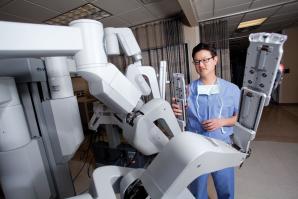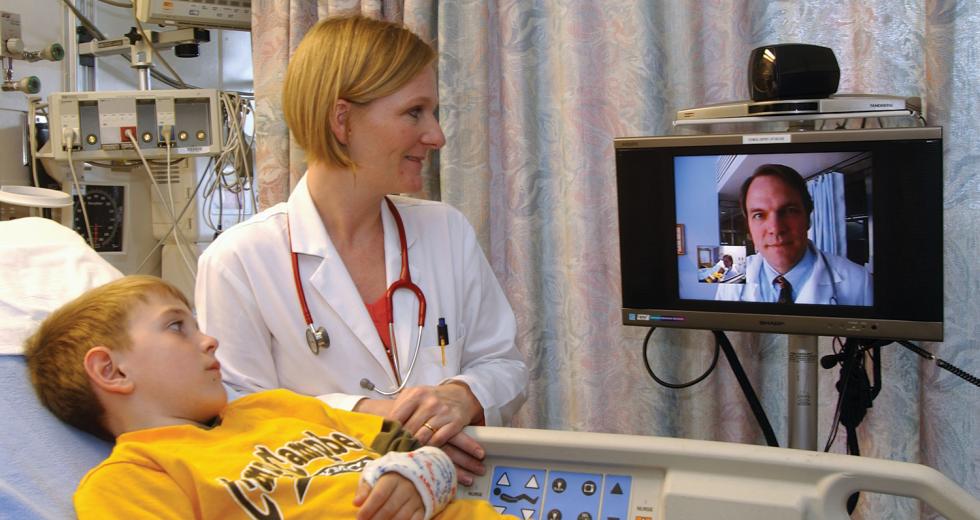An infant in Redding is turning blue, slipping away with a failing heart and lungs until a specialist in Sacramento steps in and saves the baby’s life, guiding a team of nurses via a video link.
To find the best treatments for HIV patients, a rural doctor books video consultations with a specialist, providing her patients with cutting edge advice without forcing them to drive hours to Sacramento.
On an Indian reservation in rural California, a clinic emails retinal images to an ophthalmologist in Sacramento to identify diabetic patients facing complications.
UC Davis Health System’s Telehealth Program has been providing medical solutions like these to underserved and rural areas for years. And as a leader in using technology to connect big city medical experts with patients from small towns, UC Davis’ Center for Health and Technology is playing a key role in shaping the telemedicine of the future. It’s no longer solely about Skype-like videoconferences.
Already staffers at UC Davis’ Center for Health and Technology are planning a remote surgery where a doctor in Sacramento will operate on a patient who is miles away.
“We are hoping to do it this year,” says Dr. Javeed Siddiqui, associate medical director at the Center for Health and Technology and an expert in treating infectious diseases such as HIV. “The technology is there.”
Meanwhile, phone applications have already been developed to monitor blood pressure and blood sugar levels; and most experts say it’s only a matter of time until telemedicine extends from a medical specialist’s office to a patient’s bedroom. Right now telemedicine is limited from one doctor’s office to another’s.
The only obstacles to these developments are privacy concerns and reimbursement issues. The conventional wisdom is those obstacles will be worked out in the coming years.
“Telemedicine is not restrained by technology,” Siddiqui says. “It’s restrained by policy and reimbursement.”
The driving force behind UC Davis’ telemedicine program has always been connecting medical experts with underserved areas, especially rural communities.
When the telemedicine program began in 1996, it mostly focused on video consultations in specialties such as sports medicine and dermatology. But it quickly broadened to infectious diseases, pediatrics and countless other specialties. These days, UC Davis medical experts are connecting with at least 75 clinics across the state at any given time. All told, the program has completed more than 25,000 real-time consultations throughout California.
“My interest was in, always and still is, health care disparities,” says Dr. Thomas Nesbitt, the founding director of the Center for Health and Technology and an associate vice chancellor for the UC Davis Health System.
UC Davis Telehealth Program is Nesbitt’s baby, and it’s his guiding vision that has led the way for the program’s growth and development.
“The guiding principle that Dr. Nesbitt set forth is extending access to health care for rural California,” Siddiqui says. “It’s always been helping the needs of a community.”
In the early ’90s Nesbitt saw technology as a tool for connecting rural areas with experts. He used telemedicine to rebuild an obstetrics program, providing medical care for an expecting mother and her child, in Colusa County, about 70 miles north of Sacramento.
A few years later, he started looking at other areas to use telemedicine, and from there the program grew.
“In some cases, knowledge and expertise need to be in a particular place at a particular time for someone to make the best evidenced-based decision,” Nesbitt says.
Translation: Experts need to be available to help guide decisions for patients. And with most medical experts in California living and working in urban areas, telemedicine is a great way to balance the expertise with the rest of the state.
Beyond this, though, Nesbitt and others say telemedicine can save lives and money. And the way Nesbitt sees it, the coupling of electronic medical records with telemedicine will make for a powerful tool in the years to come.
“The right decision at the right time is, in general, more cost-effective than multiple tries at the wrong thing,” he says.
For example, take the UC Davis pediatrics telemedicine program, which was the first of its kind in the country. With a limited number of pediatric intensive-care units in the region, Dr. James Marcin saw telemedicine as a way to connect specialists with non-pediatricians in rural areas.
“These communities would sometimes send kids (to Sacramento) that wouldn’t need to be sent,” Marcin says.
And sometimes they wouldn’t send kids who really needed to be in the care of specialists.
By using telemedicine, Marcin and other pediatric specialists have been able to sort out these quality control issues, making sure kids receive the right treatment in the best location. But they are also often able to keep kids in their home communities where they can stay connected to family and friends.
Like the rest of UC Davis’ telehealth program, pediatric telemedicine has grown.
What started out as simply connecting rural doctors with medical experts in big cities has evolved into something much more. These days, the telemedicine network is used to connect kids who are moved to Sacramento for care with their families and friends back home.
For example, Marcin has a video of a teenage girl who used the telehealth link to connect with friends at her high school during lunch hour. They talked almost every day.
The video link has also been used to assist with sexual abuse investigations — allowing doctors and nurses in Sacramento to guide rural staffers through the exams to make sure everything is done right — and there are now newborn and childhood obesity programs that are done over the telemedicine network.
“The underlying goal is to transform in a better way how health care is delivered,” Marcin says. “A picture is worth a thousand words.”
To that end, all three doctors — Marcin, Nesbitt and Siddiqui — see telemedicine as playing a huge role in how medicine is practiced in the future, becoming increasingly conventional in every day practice.
Nesbitt sees it as a potentially cost-effective way to provide basic care to people with low incomes and as a way to provide bedside checks in a person’s home, saving them a potentially exhausting trip to the doctor’s office.
Marcin sees cell phone apps as potentially playing a key role in how doctors monitor patients. And Siddiqui says it’s as simple as changing how medicine is delivered while improving the comfort and care for patients.
“Medicine is an incredibly inefficient business,” he says, describing the countless office visits and waiting rooms patients have to navigate as they move from a general doctor to a specialist to lab tests. “What is it that says a patient has to drive 3.5 hours, 4.5 hours, to see me for an office visit?
“We really believe in what we are trying to do here,” he adds. “Someone is getting access to a type of care that they otherwise wouldn’t have access to.”
Rural California: Access to technology and health
care
935
residents exist per doctor in rural California, compared to 460
residents per doctor in urban areas of the state. Almost half the
state’s rural population lives in regions designated as health
professional shortage areas and is in need of telemedicine.
$22.1 million
will be provided to California by the federal government’s Rural
Health Care Pilot Program over three years to connect more than
300 health care providers in underserved areas to a state and
nationwide broadband network.
77 percent
of rural homes now have broadband connections, up from 63 percent
in 2008.
$60 million
would be spent by the nonprofit California Emerging Technology
Fund over the next five years to advance broadband quality and
access across the state.
$4.35 billion
would be provided by the federal Broadband Technology
Opportunities Act for grants and initiatives supporting training,
access, equipment and support to health care providers to
facilitate greater broadband and telemedicine services. The
funding is part of the American Recovery and Reinvestment Act of
2009.
SOURCES: CENTERS FOR DISEASE CONTROL, FEDERAL COMMUNICATIONS COMMISSION AND NATIONAL RURAL HEALTH ASSOCIATION
Recommended For You

Convenient Care
How concierge medicine is changing the health care marketplace
Think of your best friend, a friend that knows all your ticks, hobbies and vices. Now imagine this friend happens to be a doctor, and she’s your doctor.

Head-Turning Technology
Advanced treatment promises better outcomes for prostate cancer
Rollie Swingle didn’t have treatment options for his stage IV prostate cancer.



